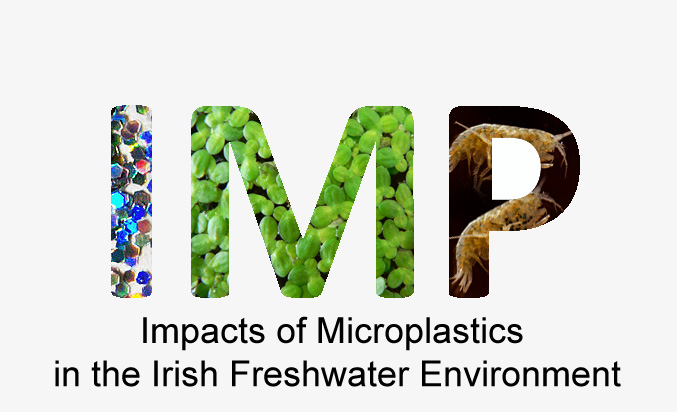Impact of Microplastics in the Freshwater Environment (IMP)

The Irish Environmental Protection Agency (EPA) funded a 3-year research project from 2017-2020 aiming to quantify the impacts of microplastics on fresh water organisms. The project was supervised by Prof. Marcel Jansen, Dr Frank van Pelt, and Prof. John O’Halloran. PhD student Ms Alicia Mateos Cárdenas executed the research, leading to the publication of several publications as well as a PhD thesis. A full EPA Research report was also published and can be found on the EPA website.
Objectives
The central objective of this project is to explore the impacts of microplastics on Irish fresh water aquatic organisms and ecosystems. This knowledge will inform monitoring programmes and regulatory policy by identifying those microplastics that pose the biggest risks to the freshwater environment.
Microplastics are plastic particles smaller than 5mm. These particles are widespread in seas and oceans, and their harmful effects on many different marine animals are well known. In contrast, we know relatively little about microplastics in fresh water: its sources, environmental fate, and biological impacts. Several large scale projects are currently working to develop monitoring technology for microplastics, as well as creating models to explain its spread and build-up. This is the approach taken by our collaborators at GMIT (see GMIT https://freshwatermicroplastics.com/). However, microplastics can vary greatly in chemical composition, size, shape and concentration, and may have different toxic effects under fresh water conditions than in the marine environment. Therefore, more information is needed to identify those microplastics posing the biggest risk for fresh water species and the freshwater environment.
Microplastics in the environment
Microplastics are either resulting from fragmentation of larger plastic objects, or specifically produced as small plastic microparticles for use in products such as cleaning agents, cosmetics, and toiletries. It is estimated that the island of Ireland emits some 5700 kg microplastics per year. Fibres released when washing (synthetic) clothes could produce even more microplastics again. Microplastics end up in the fresh water environment, either via a sewage/waste treatment plant, or directly (e.g. road run-off).
Once in the environment, microplastics are extremely persistent, although we need to know more about their fate in the fresh water environment.
Uptake of microplastics
Microplastics enter the food chain when they are consumed by small filter feeders (e.g. mussels, krill), or grazers (e.g. snails), or taken up by plants. These in turn are eaten by larger organisms, leading to a build-up of microplastic levels. High concentrations of microplastics have been found in organisms like fish, whales, turtles and birds. Little is known about microplastics in the fresh water food chain. This is an important issue, since evidence is emerging that microplastics are present in food, although neither the source nor the impact on human consumers is well studied.
Outcomes and Publications
Regulation of production and emission of microplastics will be a key component of any strategy that aims to reduce environmental pollution by microplastics. The data generated in this project will inform policy makers, enabling development of a targeted legislative approach that focusses on those microplastics that are of most environmental concern. Furthermore, the data generated will be a stepping stone towards biomonitoring and bioremediation approaches. This project will focus on developing more in-depth knowledge, which will further define the specifics of the pathways and the impacts of microplastics on humans, species and habitats.
EDIT: The project has now finished. Find the full research report at the EPA website.
Publications from the project are:
- Mateos-Cárdenas, A., von der Geest Moroney, A., van Pelt, F.N.A.M., O'Halloran, J., Jansen, M.A.K. (2022) Trophic transfer of microplastics in a model freshwater microcosm; lack of a consumer avoidance response. Food Webs 31: e00228.
https://doi.org/10.1016/j.fooweb.2022.e00228
- Mateos-Cárdenas, A., van Pelt, F.N.A.M., O'Halloran, J., Jansen, M.A.K. (2021) Adsorption, uptake and toxicity of micro- and nanoplastics: Effects on terrestrial plants and aquatic macrophytes. Environmental Pollution 284: 117183.
https://doi.org/10.1016/j.envpol.2021.117183
- Mateos-Cárdenas, A., O'Halloran, J., van Pelt, F.N.A.M., Jansen, M.A.K. (2021) Beyond plastic microbeads – Short-term feeding of cellulose and polyester microfibers to the freshwater amphipod Gammarus duebeni. Science of The Total Environment 753: 141859.
https://doi.org/10.1016/j.scitotenv.2020.141859
- Mateos-Cárdenas, A., Jansen, A.R.J., O'Halloran, J., van Pelt, F.N.A.M., Jansen, M.A.K. (2021) Impacts of Microplastics in the Irish Freshwater Environment. EPA Research Report No. 377
https://www.epa.ie/publications/research/environment--health/Research_Report_377.pdf
- Mateos-Cárdenas, A. (2020) Impacts, fate and trophic transfer of microplastics in the freshwater environment. PhD Thesis, University College Cork.
https://hdl.handle.net/10468/10568
- Mateos-Cárdenas, A., O’Halloran, J., van Pelt, F.N.A.M., Jansen, M.A.K. (2020) Rapid fragmentation of microplastics by the freshwater amphipod Gammarus duebeni (Lillj.). Sci Rep 10, 12799. https://doi.org/10.1038/s41598-020-69635-2
- Mateos-Cárdenas, A., Scott, D.T., Seitmaganbetova, G., van Pelt, F.N.A.M., O'Halloran, J., Jansen, M.A.K. (2019) Polyethylene microplastics adhere to Lemna minor (L.), yet have no effects on plant growth or feeding by Gammarus duebeni (Lillj.). Science of The Total Environment 689: 413-421.
https://doi.org/10.1016/j.scitotenv.2019.06.359
